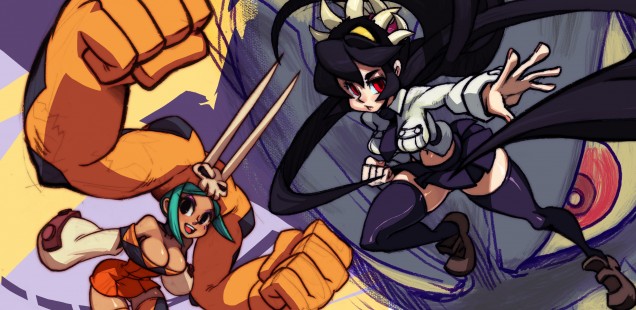
Off The Grid: Skullgirls
Forgetting more than just their clothes. By Zachary Brictson.
Fighting game enthusiasts don’t ask for much. They can pick up a new game, boot it up, and throw 90% of its features to the wayside. Most are, after all, useless to them. The rushed story, cheap end boss and completely random AI: these are mere formalities. Or the kind of mediocrities expected from ported arcade fighters.
Skullgirls originates on digital storefronts, but it wears this minimal packaging like a badge of honor, as an ode to the late 90s fighting game scene. It’s a tag based fighter with buildable meters for super attacks (Marvel vs Capcom 2), but then it also incorporates a ratio system that makes the idea of a tag team completely optional (Capcom vs SNK).
Ratios mean that a one vs. three match-up is both completely plausible and balanced. A full team contains individually weaker characters, but more tag options, while rolling solo amounts to hitting like a truck. With customizable tag attacks and this kind of dynamic approach to team composition, Skullgirls has impressive depth, especially considering its small roster size.
Having only eight characters is a bit extreme, given you can put three to a team. And the bizarre art direction doesn’t make finding favorites any easier, either. It’s like Felix the Cat had a nightmare after watching some erotic Japanese animation, an odd mix of old fashioned western cartoon charm and shameless fanservice. Freak shows, gratuitous up-skirts or bouncing breasts, take your pick.
Still, these strange gals do feature some heavily contrasting toolsets and veterans will take note of the historical archetypes at work here. One character can pop her head off and control it separately, something like the doll control seen in Guilty Gear or Blazblue. Another keeps airborne and hovers around the stage looking for offensive opportunities, a style no doubt akin to Sentinel from Marvel vs Capcom 2. The game’s got heart.
It also has some ideas of its own. A combo heavy fighter, Skullgirls attempts to encourage creativity over memorization by incorporating an infinite prevention system. This allows players to break free of combos that begin to loop or repeat themselves, though it’s currently in dire need of patching. As of writing, the computer doesn’t differentiate between a light punch and a light kick, allowing players to fool the system and still perform egregious combos.
But they sure look good, with moves that smack, whack, snip and smash with a clean sense of hit confirmation. It’s crisp. Even when a full blown three on three creates chaos all over the screen, the art never stutters or overlaps. This smoothness is enough to warrant some serious inspection at the competitive level, plus it’s got a lagless net code. Take that, Capcom.
With fixes and additional expansion allegedly on the horizon, Skullgirls stands as a shrewd mash-up of historically beloved mechanics and could well be on its way to being one of the more legitimate competitive experiences in the genre. But it’s currently missing things, like characters, and character move lists. Seriously, they aren’t in there. You have to Google them.
Zachary Brictson is a Computer Science graduate from Northern Illinois University who chooses to write about games rather than code them, contributing to physical publications like The Printed Blog, sites such as Playstation Universe, and his own blog, Up Magic.